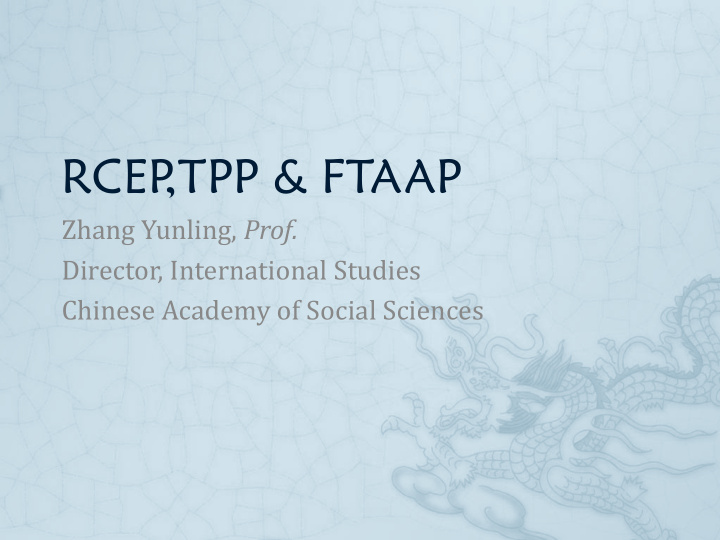



RCEP ,TPP & FTAAP Zhang Yunling, Prof. Director, International Studies Chinese Academy of Social Sciences
RCEP (1) Many efforts made on how to integrate the divided East Asia by multilayered FTAs since 2004 --EAFTA feasibility studies led by China and ROK (2004-2006, 2007-2009) --CEPEA study led by Japan(2006-2009) --China-Japan joint proposal in 2010 --ASEAN decision on RCEP in 2011, and formal initiative in 2012 by 16 countries
RCEP (2) RCEP as a response to TPP by ASEAN, and also a result of consolidating process of EAFTA and CEPEA RCEP is identified as a modern, comprehensive and mutual benefit FTA, with higher level than current 5 “10+1” FTAs RCEP covers ” trade in goods, trade in services, investment, economic and technical cooperation, intellectual property, competition, dispute settlement and other issues”
RCEP(3) RCEP seeks a different model and approach from TPP As recommended by the expert roundtable (2013): gradual progress: trade in goods (2015), trade in service and investment (2020), other difficult issues (2025); comprehensive down payments in 2015, final completion (2025); AEC extension and connection
RCEP (4) RCEP is structured as the negotiation between ASEAN and 6 partners The first round started on May 10,2013 and the third round just finished in the end of January, 2014 (modality), and the fourth will be held in April (framework), Economic ministers’ meeting to be held in August (with real progress) ASEAN: expects a gradual and flexible process India: with low commitments Japan: high level and comprehensive, but with special exceptions Key: consensus based on smart compromises Challenge: negative list on service (not easy, ASEAN has not agreed) , pre-national treatment (relatively easy) and TPP effects (TPP members)
China(1) China’s FTA strategy started from 2000 after joining WTO, with the initiative of CAFTA Until now, China has concluded FTAs only with: --Developing economies: ASEAN as a group, Pakistan, Chile, Peru, Cost Rica, Trinidad Tobago --Small developed economies: Switzerland, New Zealand, Iceland --Internal arrangement: HK, Macao, Taiwan Experience: gradual (ASEAN), less competitive (small) and special (HK, Taiwan and Macao)
China(2) China has met difficulties in negotiating FTAs with: --Larger developed economies: like Australia on service --Large developing economies: like India with negative response --Special group: Gulf council on chemical sector Reasons: --China’s competitiveness: FDI based export, local sectors, especially service sector, are weak --China as an export center: competitiveness and trade surplus with developing markets --US, EU refuse to accept China’s market status
China (3) China has negotiated BIT with US and EU, and possible FTAs with them in the future China has made new commitments on adopting the principles of negative list approach and pre-national treatment FTA has been taken as a central strategy in the reform agenda CK FTA, CJK FTA, RCEP
TPP TPP is considered as a serious challenge to China both because: --US strategy against a rising China --New rules relating to domestic reform Divided views: --Early participating TPP --Wait and see Official: open, but cautious
WTO WTO is still basic and fundamental Bali facilitation package is an important step China shows strong interest to participate ITA2, TISA, and also a possible investment agreement However, there are difficulties for WTO to adopt all new rules made by TPP, TTIP
APEC APEC is still a key institution bridging the Asia-Pacific Bogor goal remains as a goal, but no vehicle: --TPP as a leading vehicle? --TPP + RCEP? --FTAAP? APEC in 2014: FTAAP initiative?
Recommend
More recommend